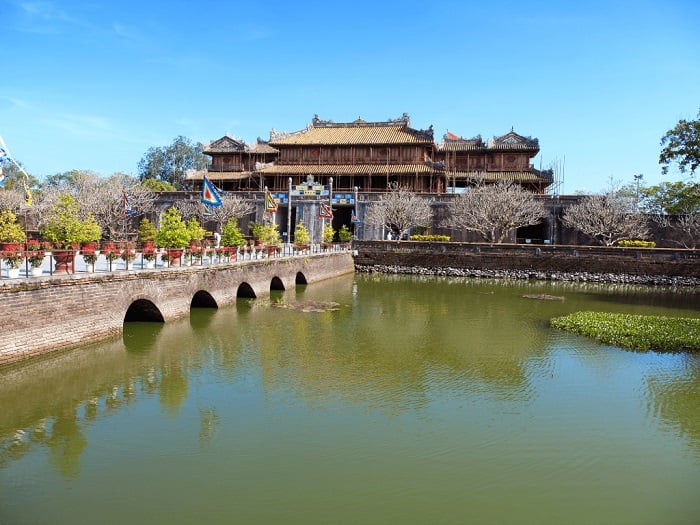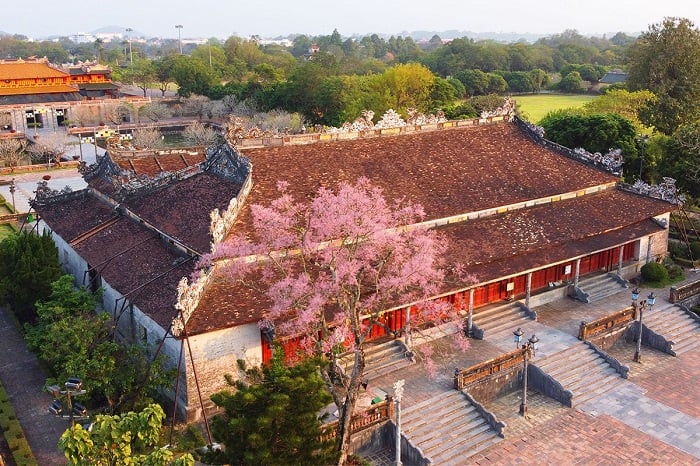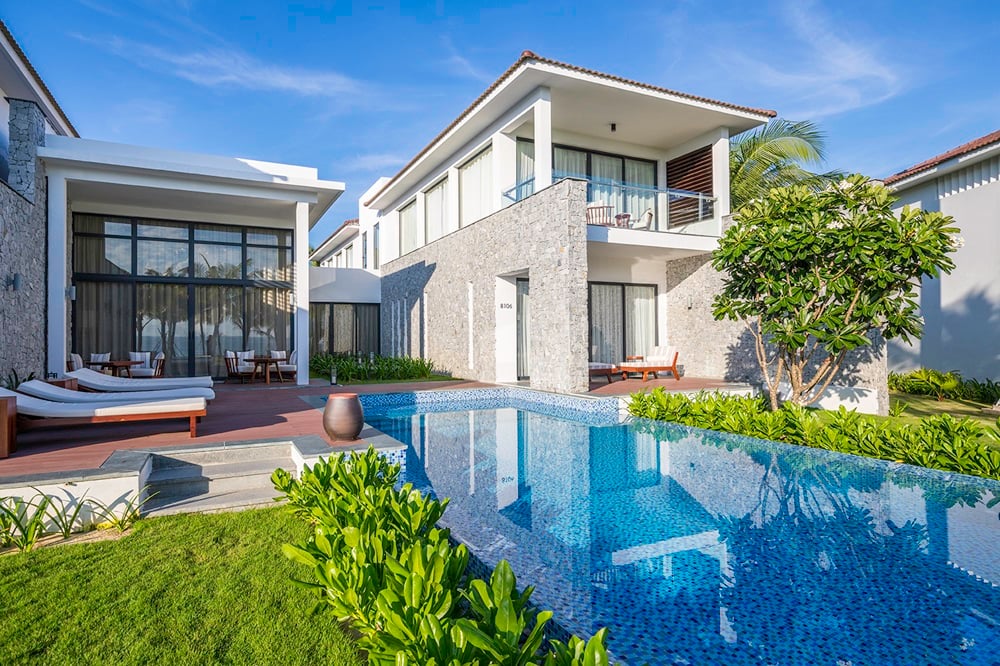
Rich in history and studded with remarkable ancient sites, the city of Hue Vietnam is an ideal destination for history enthusiasts. Hue Historic Citadel, a UNESCO World Cultural Heritage site, is a must-see attraction that any Hue tour should not miss out on. Hue Citadel still well retains many architectural masterpieces and distinctive cultural values.
1. Hue Historic Citadel: Location, opening hours, entrance fee
1.1. Where is Hue Historic Citadel?
- Location: 23/8 Street, Thuan Hoa Ward, Hue, Vietnam
- Hue Citadel opening hours:
- Summer: 8:00 AM - 5:30 PM every day
- Winter: 7:30 AM - 5:00 PM every day
Hue Historic Citadel is a walled fortress that served as the capital of the Nguyen Dynasty, the last feudal dynasty in Vietnam, from 1802 to 1945. It is situated on the northern bank of the Perfume River, covering a total area of 520 hectares. The citadel in Hue Vietnam was designated a UNESCO World Cultural Heritage Site in 1993 thanks to its significant architectural and historical values.

1.2. Citadel Hue entrance fee 2023
1.2.1. The Imperial City
- Entrance fee:
- Adults: 200,000 VND
- Children (from 7 to 12 years old): 40,000 VND
- Children under 6 years old: free
1.2.2. The royal tombs
- Tombs of Emperor Minh Mang, Tu Duc, and Khai Dinh:
- Adults: 150,000 VND
- Children (from 7 to 12 years old): 30,000 VND
- Children under 6 years old: free
- Tomb of Emperor Gia Long:
- Adults: 150,000 VND
- Children under 12 years old: free
- Tomb of Emperor Dong Khanh:
- Adults: 100,000 VND
- Children under 12 years old: free
- Tomb of Emperor Thieu Tri:
- Adults: 50,000 VND
- Children under 12 years old: free
1.2.3. Other relics inside Hue Citadel
The entrance fees of other sites inside Hue Historic Citadel, including Hue Museum of Royal Fine Arts, Hon Chen Temple, Nam Giao Esplanade, and An Dinh Palace are 50,000 VND per adult. Children under 12 years old can enter free of charge.
2. The long-standing history of Hue Historic Citadel Vietnam
In the 19th century. Emperor Gia Long relocated the nation's capital from Thang Long (today’s Hanoi) to Hue. He built a palace complex in Hue that was modeled after Beijing's Forbidden City. Geomancers were consulted to determine the ideal location for the new capital. The construction of the Hue Historic Citadel started in 1803, and it took nearly 30 years to finish this massive complex.

The complex of the Hue Historic Citadel served as the center of authority until the French protectorate was established in the 1880s. The Nguyen Dynasty was overthrown in 1945 when the Democratic Republic of Vietnam declared independence. On August 30, 1945, a ceremony announcing the abdication of Emperor Bao Dai took place in Hue Imperial Citadel Vietnam, marking the end of the last feudal dynasty of Vietnam.
3. What to explore about the structure of Hue Historic Citadel?
3.1. The overall structure of Hue Historic Citadel
Hue Historic Citadel has a perimeter of 10 kilometers. Forts are positioned around the city, accompanied by cannons. Bricks were later added to the fortification, which was originally just constructed of soil. An intricate network of canals surrounds the city, serving not just as a means of defense but also as a nearly seven-kilometer-long waterway.
Hue Historic Citadel is separated into two main sections: the Imperial City and the Forbidden City. The former served as a shield for the significant palaces inside, and the latter served as both the working place and the residence of the emperor and his royal families. This architectural masterpiece is formed by the harmonious arrangement of typical Eastern architectural works, including grand palaces, tombs, and museums.

Many royal architectural structures inside Hue Historic Citadel were severely damaged by bombings during the wars in the 20th century. Nowadays, less than half of the stunning original complex remains. Still, the Imperial Citadel in Hue, Vietnam, is a worthwhile destination for any Vietnam tour.
Below are some outstanding structures inside the Hue Historic Citadel that tourists should not miss out on in this poetic city.
3.2. Outstanding historic sites inside the Citadel of Hue
3.2.1. Ngo Mon (the Meridian Gate or the South Gate)
Ngo Mon is one of the four main gates that lead to the Forbidden City. It is located to the south of the Imperial City. The gate consists of two levels and was formerly used only by the emperor or to welcome foreign ambassadors.
The ground level consists of five entrances. The main entrance in the middle was always for emperors, while the two smaller side entrances were for mandarins. Soldiers, horses, and commoners passed through the gate via the two remaining tiny arched entrances.

“Lau Ngu Phung” (Five Phoenix Pavilion) is the name of the second level of Ngo Mon in Hue Historic Citadel. It has two floors that are entirely made of the precious Tali wood. The Pavilion's roof is embellished with sculptures of various animals and mythical creatures (such as Vietnamese phoenixes) to ward off evil spirits, giving the structure a graceful appearance.
3.2.2. Thai Hoa Palace
Thai Hoa Palace, which is situated in the heart of the Hue Historic Citadel, served as the venue for many significant court rituals of the Nguyen Dynasty. The 1,360-square-meter palace was constructed on a 1-meter-high platform overlooking a spacious yard. This structure is supported by 80 pillars made of Tali wood.

In order to reduce the weight and give the building a sense of height, the roof of Thai Hoa Palace in Hue Historic Citadel is made of glazed tiles that are separated into three layers rather than being joined together. Thai Hoa Palace has undergone several renovations, but the architectural layout and decorations are still well preserved.
3.2.3. Ky Dai (Hue Flag Tower)
The Flag Tower is one of the most famous spots for taking photos in Hue Historic Citadel. Located in front of Ngo Mon, the tower was constructed in 1807 and has undergone numerous expansions and renovations.

On the top of the flagpole, there is an observation station called “Vong Dau”. There were times when the guards had to climb Vong Dau and use the telescope to look out toward the shore. Today, the national flag of Vietnam flies on the top of the tower.
3.2.4. Dien Tho Palace
Dien Tho Palace is the largest palace system in the Forbidden City that still remains today. It was formerly the home of the mothers and grandmothers of the Nguyen emperors. Over 20 large and small architectural works of various styles are spread across Dien Tho Palace's area of about 17,500 square meters.
3.2.5. Can Chanh Palace
The Forbidden City's Can Chanh Palace is where the emperors governed the court, welcomed foreign ambassadors, and hosted royal banquets. With a platform approximately one meter high and an area of approximately 1,000 square meters, this palace is the largest and most exquisite wooden construction in Hue Historic Citadel.

4. Top 5 best experiences for your trip to Hue Historic Citadel
4.1. Get around the Citadel by cyclo
A cyclo tour is the best idea to explore Hue Historic Citadel if you are not fond of walking. Since the Imperial City is very large, it will take a lot of time to walk around. By taking a cyclo, travelers will have more time to discover the exquisite sites here.
You can choose either to book a cyclo tour in advance or just ask any random cyclo rider at the ticket booth. Breathing in the fresh air while contemplating the antique beauty of the Imperial City will be such a joyful experience to have in Hue Vietnam.

4.2. Explore the mausoleums and palaces of the Nguyen emperors
Aside from the Imperial City, the complex of the Hue Historic Citadel also has many other significant historical sites, especially the seven royal tombs of the Nguyen emperors. The emperors designed their personal tombs themselves; thus, the tombs well reflect their diverse personalities and beliefs.
These locations serve two purposes: as the emperor's temporary workplace, residence and leisure area; and as their final resting place. There are a total of 7 royal tombs in the Hue Historic Citadel, but only one of them (Khai Dinh Tomb) still remains intact today. The three most impressive tombs to see are those of Emperors Khai Dinh, Minh Mang, and Tu Duc.

4.3. Admire the beauty of Hue Historic Citadel at night
Hue Historic Citadel also has one of the most beautiful nightlife scenes in Hue. Tourists can visit Hue Citadel night street every Friday and Saturday from 7:00 PM to 11:00 PM, where you can see the guarding ceremony - a custom from the Nguyen Dynasty, as well as traditional games and art performances. There are plenty of food vendors on the night street with scrumptious Hue delicacies to enjoy.

4.4. Enjoy the Royal Tea Ceremony at The Mosaic of Hue
Hue royal tea is one of the prides of the citadel. As its name implies, it used to be for the emperors and royal families only. Watching the Royal Tea Ceremony at Dong Khuyet Dai (The Mosaic of Hue) is hence an experience that tourists should not miss out on when they come to this ancient capital.
This area serves as a gallery for ancient exhibits and traditional performances. The ritualistic tea ceremonies are performed by beautiful tea ladies dressed in the traditional attire of the Nguyen Dynasty. You will also have the chance to try the royal cakes, which are the best dessert to go with the Hue royal tea.

4.5. Participate in royal festive activities
The best time to visit Hue Historic Citadel for history buffs is during the Hue Festival - a biannual cultural event in Hue Historic Citadel. There are several interesting activities during this time, such as live performances, the Hue Poetry Festival, the Ao Dai fashion show, etc. Competitions including boat races, human chess, and kite flying contests are also some highlights on this occasion.

5. Useful notes for the best experience in Hue Historic Citadel
- It is better to start your Hue Historic Citadel tour in the morning or early afternoon, as there are a lot of sites to visit and things to do here.
- January and February are when the weather in Hue is the most pleasant. In case you want to join the Hue Festival, come between April and June.
- Bring a hat and freshwater, as you will walk around a lot in the Hue Historic Citadel.
- If you want to see the whole complex in one day, you can purchase a combo ticket that includes both the Imperial City and the Royal Tombs to save money.
- Get a Hue Historic Citadel map so that you will not get lost inside this massive complex.
- Dress politely, avoid revealing clothes.
- Do not touch the artifacts.
- Consider taking a taxi offered by XANH SM Taxi for easy travel to the citadel.
XANH SM Taxi - the first electric taxi company in Vietnam, operated entirely with VinFast electric cars. Customers who travel by XANH SM taxi not only receive an excellent standard of service, but they also join XANH SM in its efforts to reduce vehicle emissions and safeguard the environment. XANH SM provides standard and luxury taxi service, airport taxi, with attractive promotions. Customers can easily book a taxi in 04 ways:
(1) Call the national hotline 1900 2088
(2) Wave on the street like a traditional taxi
(3) Book on the Taxi Xanh SM app. Click HERE to download the app
(4) Use the beVinFast service on the multi-service customer platform BE to book Xanh SM taxi.

Hue is one of the top destinations in Vietnam, so there is an abundance of accommodation options in this city. As Hue is quite small, the famous places to visit in Hue such as the Hue Historic Citadel, Perfume River, Trang Tien Bridge, Dong Ba Market, Thien Mu Pagoda, etc. are located quite close to each other and easy to reach within a couple of minutes.
A Central Vietnam tour often includes both Hue and the neighboring destinations - Da Nang and Hoi An. If you are about to visit these places, you should book a luxury hotel or resort room in advance. With prime locations, opulent amenities, and top-class services, Vinpearl Resort & Golf Nam Hoi An is a reliable place to stay during your Vietnam trip.


>>> Book rooms in Vinpearl Resort & Golf Nam Hoi An to have a pleasant stay during your Central Vietnam tour!
Da Nang and Hoi An, the two adjacent destinations to the Hue Historic Citadel, offer exquisite natural landscapes, rich culture, and lots of fascinating activities to participate in. Notably, VinWonders Nam Hoi An, situated near the heritage town, is an enchanting spot to get exposed to the culture of Hoi An in particular and Vietnam in general. There is a water park and a river safari here, which are perfect for a family outing. If you seek adrenaline-filled activities, more than 100 indoor and outdoor games at VinWonders will definitely satisfy you.

>>> Book tickets of VinWonders Nam Hoi An to have a fancy outing near the heritage town!
Hue Historic Citadel, one of Vietnam's seven UNESCO World Heritage Sites, is a must-visit destination for travelers who love to explore the country’s rich history and culture. There are so many interesting things to do in Hue Vietnam, so make sure you do not miss out on this place!














_1742996408_1743220457.jpg)
_1743220365.jpg)

















